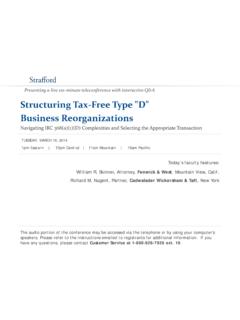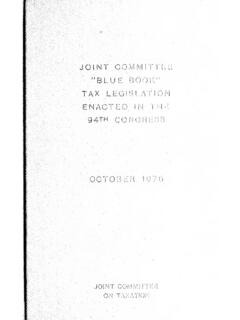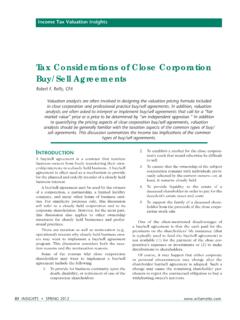Transcription of Part I. Rev. Rul. 2019-13 ISSUE
1 Part I. section 1368. Distributions 26 CFR : Distributions by S corporations (Also: 301, 302, 1362, 1367, 1371, 1377, 26 CFR ) Rev. Rul. 2019-13 ISSUE If, during a former S corporation s post-termination transition period, the corporation distributes cash in redemption of a shareholder s stock and the distribution is characterized as a distribution under 301 of the Internal Revenue Code (Code), should the corporation reduce its accumulated adjustments account (AAA) pursuant to 1368 of the Code? FACTS X is a corporation that once was a C corporation and later elected to be an S corporation under 1362(a) of the Code. X s S election terminated under 1362(d), such that it is now a C corporation.
2 A, an individual, owns all 100 shares of the outstanding stock of X. X is a calendar-year taxpayer. At the time of its conversion to an S corporation, X had accumulated earnings and profits (E&P) of $600x and no current E&P. At the time of the termination of its S election, X s AAA was $800x and its accumulated E&P was still $600x. During X s post-termination transition period, X redeems 50 of A s 100 shares of X stock for $1,000x. X makes no other distributions during the post-termination transition period. Pursuant to 302(d) of the Code, the redemption is characterized as a distribution subject to 301. For the taxable period that includes the redemption, X has current E&P of $400x.
3 LAW AND ANALYSIS section 1371(e) of the Code provides that, in general, any distribution of cash by a former S corporation with respect to its stock during the post-termination transition period (as defined in 1377(b) of the Code) is applied against and reduces the adjusted basis of the stock to the extent the distribution does not exceed the corporation s AAA (within the meaning of 1368(e)). section 1368(e) defines the AAA as an account of the S corporation, which is adjusted for the S period in a manner similar to the adjustments under 1367 of the Code (except that no adjustment is made for income (and related expenses) that is exempt from tax under the Code; the phrase (but not below zero) is disregarded in 1367(a)(2)); and no adjustment is made for Federal taxes attributable to any taxable year in which the corporation was a C corporation.
4 The term S period is defined in 1368(e)(2) as the most recent continuous period during which the corporation has been an S corporation. HOLDING If, during a former S corporation s post-termination transition period, the corporation distributes cash in redemption of a shareholder s stock, which is characterized as a distribution subject to 301, the corporation should reduce its AAA to the extent of the proceeds of the redemption pursuant to 1368. The redemption of 50 of A s 100 shares of X stock for $1,000x is characterized as a reduction of X s $800x of AAA with the remaining $200x characterized as a dividend under 301(c)(1). DRAFTING INFORMATION The principal author of this revenue ruling is Margaret Burow of the Office of Associate Chief Counsel (Passthroughs and Special Industries).
5 For further information regarding this revenue ruling, contact Margaret Burow at (202) 317-5279 (not a toll-free number).
















